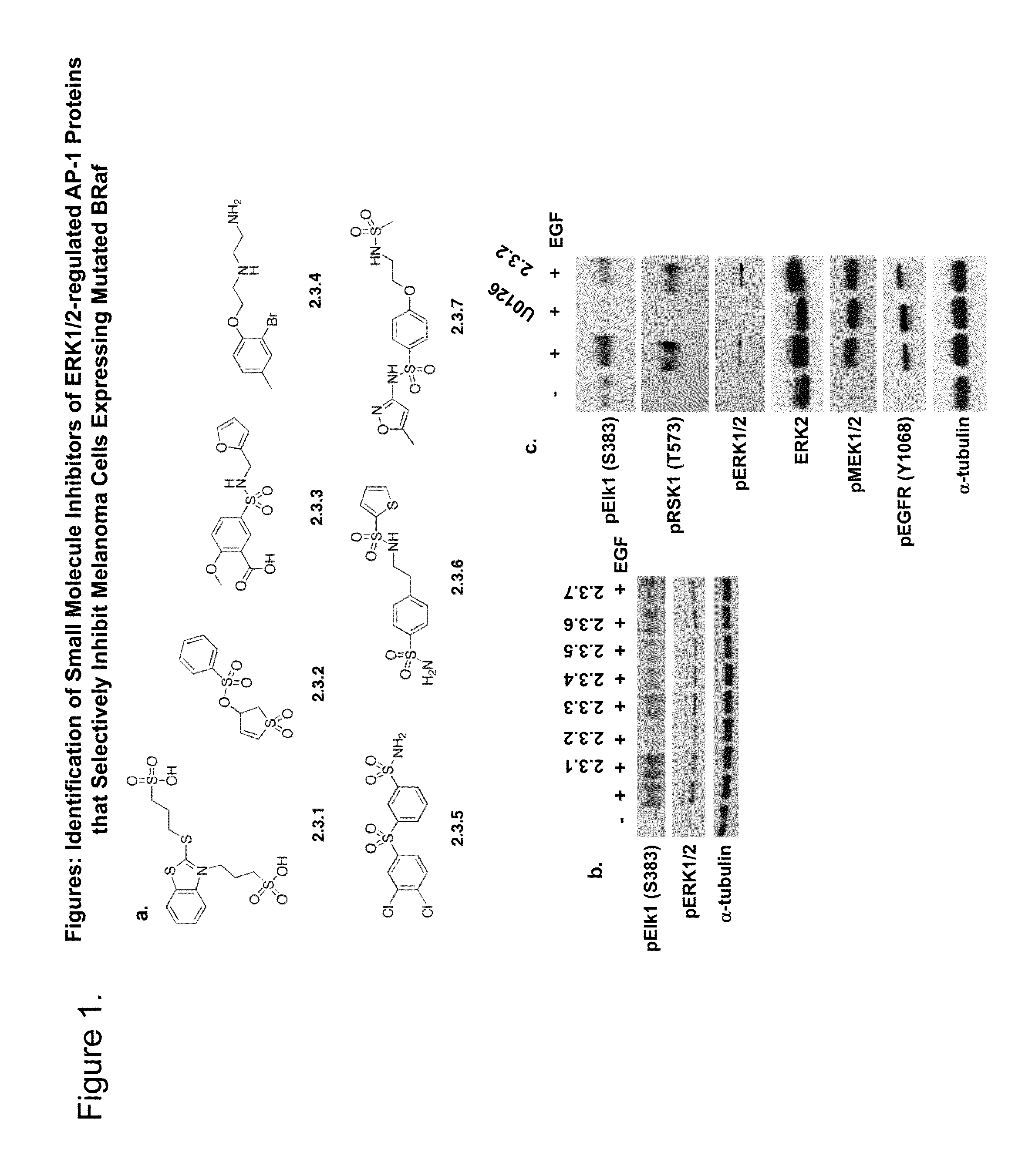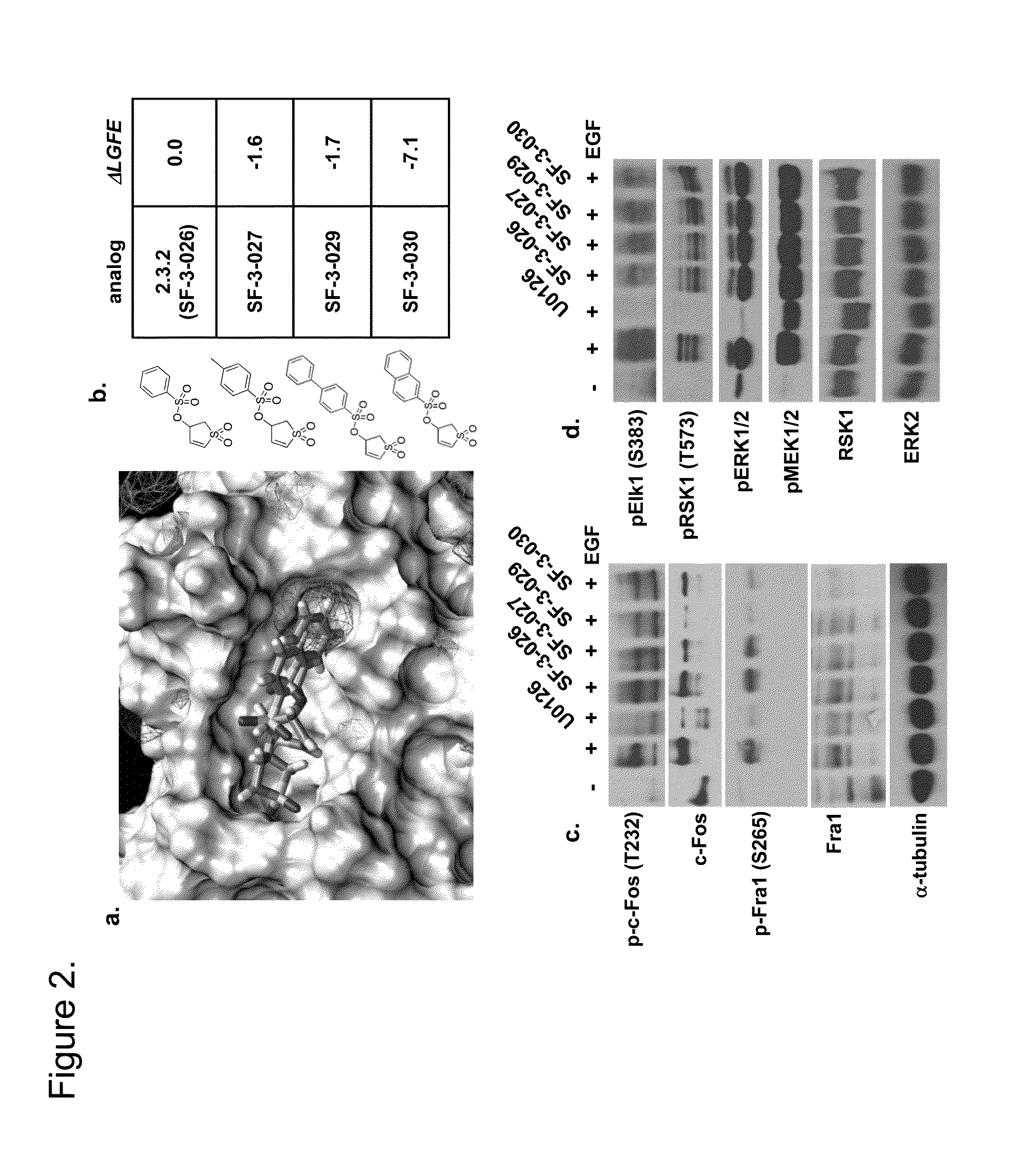Non-ATP dependent inhibitors of extracellular signal-regulated kinase (ERK)
a signal-regulated kinase and non-atp-dependent technology, applied in the field of inhibitors of extracellular signal-regulated kinase (erk), can solve the problems of poor survival outcomes, limited use of many of these targeted compounds, and compounds that have not advanced to the clini
- Summary
- Abstract
- Description
- Claims
- Application Information
AI Technical Summary
Problems solved by technology
Method used
Image
Examples
example 1
[0193]Computer aided drug design (CADD) was used to identify small molecular weight compounds that inhibit ERK1 / 2-mediated phosphorylation of substrate proteins in an ATP-independent manner and inhibit cancer cell proliferation in in vitro and in vivo models. This approach targeted the DRS region of ERK2, such that the identified inhibitors containing a thiazolidinedione scaffold that may selectively regulate distinct ERK2 signaling functions. From those efforts, several compounds were identified that inhibit phosphorylation of selected ERK1 / 2 substrates, including D-domain containing substrates RSK-1 and caspase-9, and selectively inhibit cancer cell lines containing constitutively active ERK1 / 2 signaling.
[0194]The present inventors have identified a class of small molecules, based on a thienyl benzenesulfonate scaffold, which are putative inhibitors of substrates that interact with ERK1 / 2 through the FRS. The compounds were initially identified using virtual database screening fol...
example 2
[0236]Materials. Test compounds were solubilized in spectrophotometric grade dimethyl sulfoxide (DMSO) and stored as 25 mM stocks at −20° C. Unless indicated, all chemicals were purchased from Sigma Aldrich (St. Louis, Mo.) and / or Fisher Scientific. All cell lines were purchased from American Type Culture Collection (ATCC, Manassas, Va.) and maintained in complete medium consisting of Dulbecco's modified Eagle medium (DMEM) plus 10% fetal bovine serum (FBS, Atlanta Biologicals, Lawrenceville, Ga.) and antibiotics (penicillin, 100 U / ml; streptomycin, 100 μg / ml) (Invitrogen, Carlsbad, Calif.). Epidermal growth factor (EGF) was purchased from Sigma (St. Louis, Mo.) and used at final concentrations of 25 ng / ml. U0126 (Calbiochem) or the ATP-competitive pyrazolylpyrrole ERK inhibitor (Santa Cruz Biotech.) were used at final concentrations of 10 μM.
[0237]Protein Expression and Purification.
[0238]ERK2 transformed cells were grown in LB medium with 100 mg / ml ampicillin and protein expressio...
example 3
[0266]CADD and biological testing to identify compounds that interact with novel ERK substrate docking sites. The known ERK2 docking sites include the DRS (site 1) and FRS (site 5) regions, whereas predicted docking sites are labeled sites 2-4 (Table 6). One compound, 76, that targets the DRS is being marketed by Calbiochem / EMD Biosciences (Cat#328006) as an ERK inhibitor. Successful inhibitor identification to date has been based on a combination of fluorescence quenching (FQ) of ERK2 wild type and docking site mutants in the presence of test compound. We currently have 14 mutations in ERK2 that cover residues in sites 1-5 (Table 6) and have used these mutants in FQ assays to evaluate regions that may be targeted by putative inhibitors identified by CADD (Table 7). This approach in combination with CADD predictions were able to identify 2 compounds that appear to target ERK2 on the putative substrate docking sites 2 (2.14) or 4 (4.57).
[0267]Tables 6 and 7
[0268]
TABLE 1ERK2 docking s...
PUM
| Property | Measurement | Unit |
|---|---|---|
| pH | aaaaa | aaaaa |
| pH | aaaaa | aaaaa |
| MW | aaaaa | aaaaa |
Abstract
Description
Claims
Application Information
 Login to View More
Login to View More - R&D
- Intellectual Property
- Life Sciences
- Materials
- Tech Scout
- Unparalleled Data Quality
- Higher Quality Content
- 60% Fewer Hallucinations
Browse by: Latest US Patents, China's latest patents, Technical Efficacy Thesaurus, Application Domain, Technology Topic, Popular Technical Reports.
© 2025 PatSnap. All rights reserved.Legal|Privacy policy|Modern Slavery Act Transparency Statement|Sitemap|About US| Contact US: help@patsnap.com



